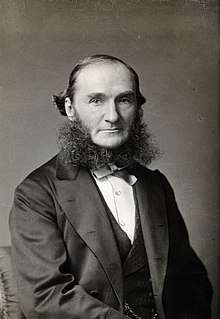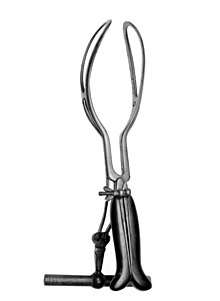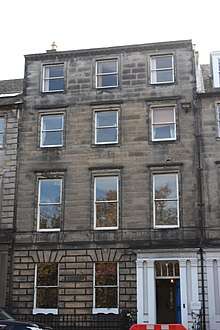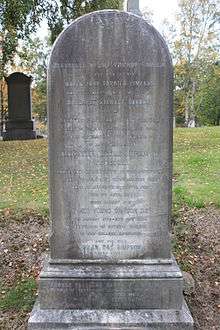Alexander Russell Simpson
Sir Alexander Russell Simpson FRCPE FRSE LLD (20 April 1835–6 April1916) was a Scottish physician and Professor of Midwifery at the University of Edinburgh.[1] He invented the axis-traction forceps also known as the obstetrics forceps which assisted in childbirth and reducing pain.[2]
Alexander Russell Simpson FRCPE FRSE | |
|---|---|
 | |
| Born | 30 April 1835 Bathgate, Scotland |
| Died | 6 April 1916 (aged 80) |
| Resting place | Grange Cemetery, Edinburgh 55.935228°N 3.187578°W |
| Nationality | Scottish |
| Alma mater | University of Edinburgh |
| Known for | inventor of obstetrical forceps |
| Spouse(s) | Margaret Stewart Barbour |
| Scientific career | |
| Fields | obstetrics |
| Institutions | University of Edinburgh, Royal Society of Edinburgh |



Life
Simpson was born in Bathgate on 30 April 1835, the son of Alexander Simpson (1797–1877), and nephew of James Young Simpson. He was educated locally then studied medicine primarily at the University of Edinburgh but also at Montpellier, Berlin and Vienna, graduating with an MD in 1856.[3]
From 1865 to 1870 he operated a doctor's surgery in Glasgow at 1 Blythswood Square.[4] In 1870, on the death of his uncle, Professor James Young Simpson, he inherited his uncle's large townhouse at 52 Queen Street in Edinburgh[5] and returned to that city, also taking over his uncle's position at the University of Edinburgh as Professor of Midwifery.[6]
In 1871 he was elected a Fellow of the Royal Society of Edinburgh his proposer being John Hutton Balfour. He was President of the Medico-Chirurgical Society in 1889 and President of the Royal College of Physicians of Edinburgh from 1891 to 1893.[3]
| Party | Candidate | Votes | % | ± | |
|---|---|---|---|---|---|
| Liberal Unionist | Robert Finlay | 5,205 | 65.9 | −2.0 | |
| Liberal | Alexander Russell Simpson | 2,693 | 34.1 | N/A | |
| Majority | 2,512 | 31.8 | −4.0 | ||
| Turnout | 7,898 | 69.8 | +5.1 | ||
| Registered electors | 11,319 | ||||
| Liberal Unionist hold | Swing | N/A | |||
He was a member of the United Free Church of Scotland and helped to run the Carrubbers Close Mission. He was a strong supporter of the Temperance Movement.[8]
He retired in 1905 and was knighted in 1906.[9]
He died in a road accident on 6 April 1916, and was buriedon 10 April in Grange Cemetery in the south of Edinburgh.[3] The grave lies in the main south-west section.
Publications
- On the Head Flexion in Labour (1879)
- Contributions to Obstetrics and Gynaecology (1880)
- Section on Obstetrics in 11th edition of Encyclopædia Britannica (1911)
Family
In 1872 he married Margaret Stewart Barbour (d.1911), sister of Professor Alexander Hugh Freeland Barbour.[3][9] She was an author and wrote Awakings or Butterfly Chrysalids in 1892.[10]
Their children included James Young Simpson and George Freeland Barbour Simpson (1875–1958).
He was grandfather to the geographer Alexander Rudolph Barbour Simpson FRSE (d.1977).
He was paternal uncle to Thomas Blantyre Simpson FRSE QC.
Artistic recognition
His sketch portrait of 1884, by William Brassey Hole, is held by the Scottish National Portrait Gallery.[11]
References
- "Sir Alexander Russell Simpson (1835-1916), Professor of midwifery at the University of Edinburgh". National Portrait Gallery. Retrieved 30 November 2016.
- A. R. Simpson, M.D., F.R.C.P.Ed. (1900). "Scot Med Surg J 1900 V-7 | The Invention and Evolution of the Midwifery Forceps – The Inaugural Address to the Midland Medical Society at Birmingham on 26th October, 1900" (PDF). Retrieved 25 February 2018.CS1 maint: multiple names: authors list (link)
- Biographical Index of Former Fellows of the Royal Society of Edinburgh 1783 – 2002 (PDF). The Royal Society of Edinburgh. July 2006. ISBN 0 902 198 84 X. Archived from the original (PDF) on 4 March 2016. Retrieved 26 July 2017.
- Glasgow Post Office Directory 1867
- Edinburgh Post Office Directory 1911–12
- "Sir Alexander Russell Simpson, Kt., M.D., D.Sc.(Hon. Causa), Ll.D., Emeritus Professor Of Midwifery And The Diseases Of Women And Children In The University Of Edinburgh". The British Medical Journal. 1 (2885): 572–574. 1916. doi:10.1136/bmj.1.2885.572. JSTOR 25316614. PMC 2347917.
- Debrett's House of Commons and Judicial Bench, 1916
- "SIR ALEXANDER RUSSELL SIMPSON, Kt., M.D., D.Sc.(Hon. Causa), LL.D". Br Med J. 1 (2885): 572–574. 1916. doi:10.1136/bmj.1.2885.572. PMC 2347917.
- "Simpson, Sir Alexander Russell, (30 April 1835 – 6 April 1916)", Who Was Who, Oxford University Press, 1 December 2007, doi:10.1093/ww/9780199540884.013.u202961, retrieved 15 May 2019
- Simpson, A.R. (1892). Awakings Or Butterfly Chrysalids. Retrieved 25 February 2018.
- "Professor Alexander Russell Simpson, 1835 - 1916. Professor of Midwifery and Diseases of Women and Children at Edinburgh University". National Galleries of Scotland. Retrieved 15 May 2019.